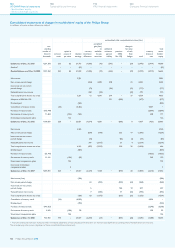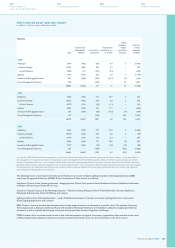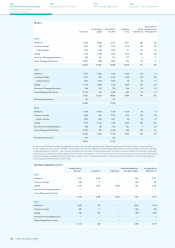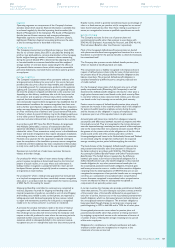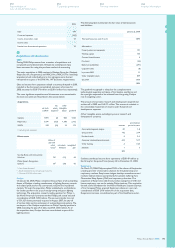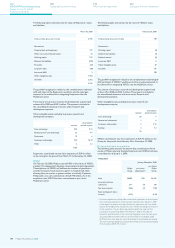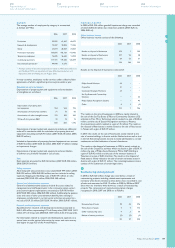Philips 2008 Annual Report Download - page 140
Download and view the complete annual report
Please find page 140 of the 2008 Philips annual report below. You can navigate through the pages in the report by either clicking on the pages listed below, or by using the keyword search tool below to find specific information within the annual report.
Inventories
Inventories are stated at the lower of cost or market, less advance
payments on work in progress. The cost of inventories comprises all
costs of purchase, costs of conversion and other costs incurred in
bringing the inventories to their present location and condition. The
costs of conversion of inventories include direct labor and fixed and
variable production overheads, taking into account the stage of
completion and the normal capacity of the production facilities. Costs
of idle facility and waste are expensed. The cost of inventories is
determined using the first-in, first-out (FIFO) method. Inventory
is reduced for the estimated losses due to obsolescence, which
establishes a new cost basis. This reduction is determined for groups
of products based on purchases in the recent past and/or expected
future demand.
Property, plant and equipment
Property, plant and equipment is stated at cost, less accumulated
depreciation. Assets manufactured by the Company include direct
manufacturing costs, production overheads and interest charges
incurred during the construction period. Government grants are
deducted from the cost of the related asset. Depreciation is calculated
using the straight-line method over the useful life of the asset. Gains
and losses on the sale of property, plant and equipment are included
in other business income. Costs related to repair and maintenance
activities are expensed in the period in which they are incurred unless
they lead to an extension of the economic life or capacity of the asset.
Plant and equipment under capital leases and leasehold improvements
are amortized using the straight-line method over the shorter of the
lease term or the estimated useful life of the asset.
The Company recognizes the fair value of an asset retirement obligation
in the period in which it is incurred, while an equal amount is
capitalized as part of the carrying amount of the long-lived asset
and subsequently depreciated over the useful life of the asset.
Intangible assets
Intangible assets are amortized using the straight-line method over
their estimated useful lives. Remaining useful lives are evaluated every
year to determine whether events and circumstances warrant a revision
to the remaining period of amortization. Intangible assets that are
expected to generate cash inflows during a period without a
foreseeable limit, are regarded as intangibles with an indefinite useful
life. These assets are not amortized, but tested for impairment annually
and whenever an impairment trigger indicates that the asset may be
impaired. In-process research and development with no alternative
use is written off immediately upon acquisition. Patents, trademarks
and other intangibles acquired from third parties are capitalized at
cost and amortized over their remaining useful lives.
Certain costs relating to the development and purchase of software
for internal use are capitalized and subsequently amortized over the
estimated useful life of the software.
Eligible costs relating to the production of software intended to be
sold, leased or otherwise marketed are capitalized and subsequently
amortized over the estimated useful life of the software.
Impairment or disposal of long-lived assets other than goodwill
and indefinite-lived intangibles
The Company accounts for long-lived assets in accordance with
the provisions of SFAS No. 144, ‘Accounting for the Impairment
or Disposal of Long-Lived Assets’. This Statement requires that
long-lived assets are reviewed for impairment whenever events
or changes in circumstances indicate that the carrying amount of
an asset may not be recoverable. Recoverability of assets to be held
and used is measured by a comparison between the carrying amount
of an asset and the future undiscounted net cash flows expected to
be generated by the asset. If the carrying amount of an asset exceeds
its estimated future undiscounted net cash flows, an impairment charge
is recognized in the amount by which the carrying amount of the
asset exceeds the fair value of the asset. The Company determines
the fair value based on discounted projected cash flows. The review
for impairment is carried out at the level where discrete cash flows
occur that are largely independent of other cash flows. Assets held
for sale are reported at the lower of the carrying amount or fair
value, less cost to sell.
Goodwill and indefinite lived intangibles
The Company accounts for goodwill and indefinite lived intangibles
in accordance with the provisions of SFAS No. 141 ‘Business
Combinations’ and SFAS No. 142 ‘Goodwill and Other Intangible
Assets’. Accordingly, goodwill and indefinite lived intangibles are
not amortized but tested for impairment annually and whenever
impairment indicators require so. An impairment loss is recognized
to the extent that the carrying amount exceeds the asset’s fair value.
This determination is made at the reporting unit level, which has been
determined by the Company to be the level of an entity that reports
discrete financial information to the Board of Management, which is
usually one level below the sector level.
The goodwill impairment test consists of two steps. First, the Company
determines the carrying value of each reporting unit by assigning the
assets and liabilities, including the goodwill and intangible assets, to
those reporting units. Furthermore, the Company determines the fair
value of each reporting unit and compares it to the carrying amount
of the reporting unit. If the carrying amount of a reporting unit exceeds
the fair value of the reporting unit, the Company performs the second
step of the impairment test. In the second step, the Company compares
the implied fair value of the reporting unit’s goodwill with the carrying
amount of the reporting unit’s goodwill. The implied fair value of
goodwill is determined by allocating the fair value of the reporting
unit to all of the assets (recognized and unrecognized) and liabilities
of the reporting unit in a manner similar to a purchase price allocation
upon a business combination in accordance with SFAS No. 141. The
residual fair value after this allocation is the implied fair value of the
reporting unit’s goodwill. The Company generally determines the fair
value of the reporting units based on discounted projected cash flows.
Share capital
Incremental costs directly attributable to the issuance of shares are
recognized as a deduction from equity. When share capital recognized
as equity is repurchased, the amount of the consideration paid, including
directly attributable costs, is recognized as a deduction from equity.
Repurchased shares are classified as treasury shares and are presented
as a deduction from stockholders’ equity.
Provisions
The Company recognizes provisions for liabilities and probable losses
that have been incurred as of the balance sheet date and for which
the amount is uncertain but can be reasonably estimated.
Provisions of a long-term nature are stated at present value when
the amount and timing of related cash payments are fixed or reliably
determinable. Short-term provisions are stated at face value.
The Company applies the provisions of SOP 96-1, ‘Environmental
liabilities’ and SFAS No. 5, ‘Accounting for Contingencies’ and accrues
for losses associated with environmental obligations when such
losses are probable and can be reasonably estimated. Additionally, in
accordance with SOP 96-1, the Company accrues for certain costs
such as compensation and benefits for employees directly involved
in the remediation activities. Measurement of liabilities is based on
current legal requirements and existing technology. Liabilities and
probable insurance recoveries, if any, are recorded separately. The
carrying amount of liabilities is regularly reviewed and adjusted for
new facts or changes in law or technology.
Restructuring
The provision for restructuring relates to the estimated costs of
initiated reorganizations that have been approved by the Board of
Management. When such reorganizations require discontinuance
and/or closure of lines of activities, the anticipated costs of closure
or discontinuance are included in restructuring provisions.
SFAS No. 146, ‘Accounting for Costs Associated with Exit or Disposal
Activities’ requires that a liability be recognized for those costs only
when the liability is incurred, i.e. when it meets the definition of a
liability. SFAS No. 146 also establishes fair value as the objective for
initial measurement of the liability.
Liabilities related to one-time employee termination benefits are
recognized ratably over the future service period if those employees
are required to render services to the Company, if that period
exceeds 60 days or a longer legal notification period.
Employee termination benefits covered by a contract or under an
ongoing benefit arrangement continue to be accounted for under
SFAS No. 112, ‘Employer’s Accounting for Postemployment Benefits’
and are recognized when it is probable that the employees will be
entitled to the benefits and the amounts can be reasonably estimated.
Philips Annual Report 2008140
180
Sustainability performance
192
IFRS financial statements
244
Company financial statements
124
US GAAP financial statements
Significant accounting policies




